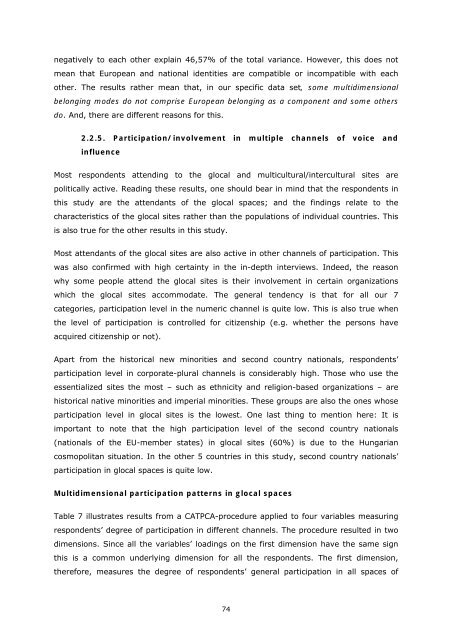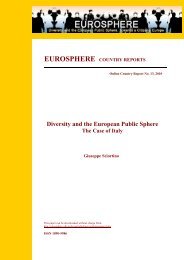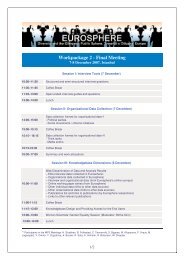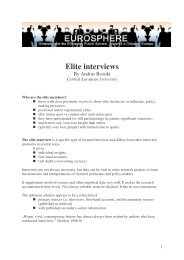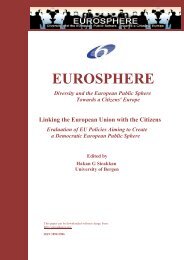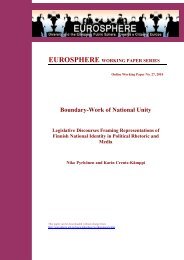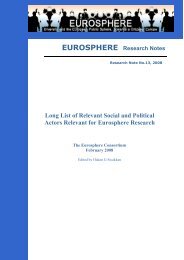Migrants, Minorities, Belongings and Citizenship. Glocalization and ...
Migrants, Minorities, Belongings and Citizenship. Glocalization and ...
Migrants, Minorities, Belongings and Citizenship. Glocalization and ...
You also want an ePaper? Increase the reach of your titles
YUMPU automatically turns print PDFs into web optimized ePapers that Google loves.
negatively to each other explain 46,57% of the total variance. However, this does not<br />
mean that European <strong>and</strong> national identities are compatible or incompatible with each<br />
other. The results rather mean that, in our specific data set, some multidimensional<br />
belonging modes do not comprise European belonging as a component <strong>and</strong> some others<br />
do. And, there are different reasons for this.<br />
2.2.5. Participation/involvement in multiple channels of voice <strong>and</strong><br />
influence<br />
Most respondents attending to the glocal <strong>and</strong> multicultural/intercultural sites are<br />
politically active. Reading these results, one should bear in mind that the respondents in<br />
this study are the attendants of the glocal spaces; <strong>and</strong> the findings relate to the<br />
characteristics of the glocal sites rather than the populations of individual countries. This<br />
is also true for the other results in this study.<br />
Most attendants of the glocal sites are also active in other channels of participation. This<br />
was also confirmed with high certainty in the in-depth interviews. Indeed, the reason<br />
why some people attend the glocal sites is their involvement in certain organizations<br />
which the glocal sites accommodate. The general tendency is that for all our 7<br />
categories, participation level in the numeric channel is quite low. This is also true when<br />
the level of participation is controlled for citizenship (e.g. whether the persons have<br />
acquired citizenship or not).<br />
Apart from the historical new minorities <strong>and</strong> second country nationals, respondents’<br />
participation level in corporate-plural channels is considerably high. Those who use the<br />
essentialized sites the most – such as ethnicity <strong>and</strong> religion-based organizations – are<br />
historical native minorities <strong>and</strong> imperial minorities. These groups are also the ones whose<br />
participation level in glocal sites is the lowest. One last thing to mention here: It is<br />
important to note that the high participation level of the second country nationals<br />
(nationals of the EU-member states) in glocal sites (60%) is due to the Hungarian<br />
cosmopolitan situation. In the other 5 countries in this study, second country nationals’<br />
participation in glocal spaces is quite low.<br />
Multidimensional participation patterns in glocal spaces<br />
Table 7 illustrates results from a CATPCA-procedure applied to four variables measuring<br />
respondents’ degree of participation in different channels. The procedure resulted in two<br />
dimensions. Since all the variables’ loadings on the first dimension have the same sign<br />
this is a common underlying dimension for all the respondents. The first dimension,<br />
therefore, measures the degree of respondents’ general participation in all spaces of<br />
74


